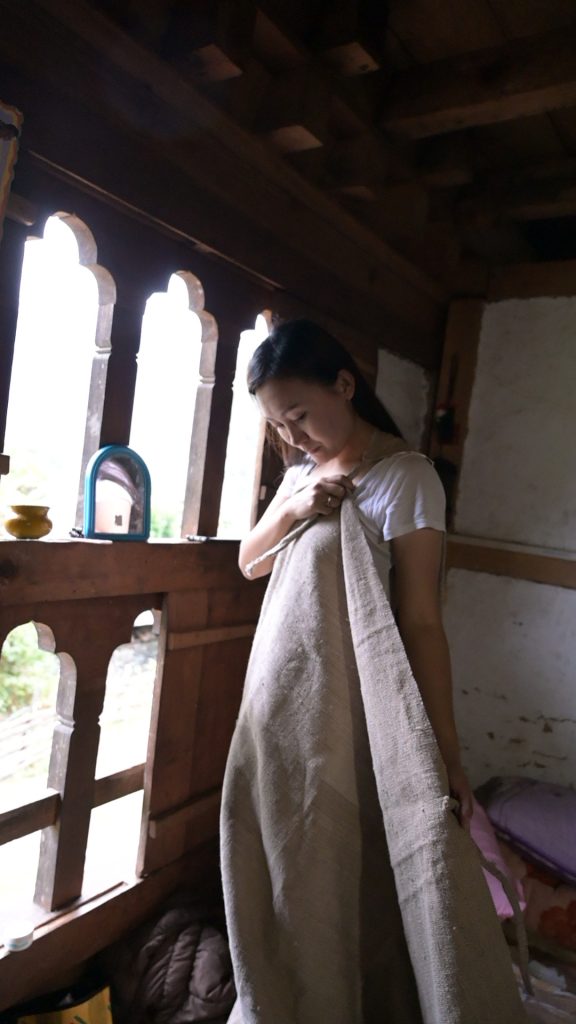
Monpa Community in Trongsa
Monpa tribes are considered to be the earliest inhabitants of Bhutan. The Monpa community in Trongsa are spread across the 3 villages of Jangbi, Phumzur and Wamling. It is recorded that there are around 375 Monpas in total.
The low numbers of the tribe also worry the communities who share the decline of their tribal culture. Elders say that the loss of their traditional mettle fabric attire called Pagay have deeply saddened them. It’s true. Monpas today no longer wear their traditional attire. Today, you can hardly differentiate a Monpa from a another local in the region.
“Kulai meng Pema” (my name is Pema) says a little girl when I asked her to teach me her dialect. Monkha is one of the most unique dialects in Bhutan. The 3 young girls studying at Jangbi Primary School fluently speak the language. I was so happy to hear that the children in the community are fluent in the dialect.

Mythical Tales
Here’s an interesting tale about the origin of the Monpas.
Did you know that the Monpas consider themselves as the descendants of one of the Sun’s nine brothers? Once upon a time, one of the brothers lived at a time when heaven and earth were at its closest distance. The Monpas were created from his union with a goddess. From their way of life, it is evident that the people still have deep reverence to the natural elements. The tribe still practices bonism, worshiping the mountains, the moon and the Sun. This truly is a magical land.
Monpa Museum in Jangbi
The community of Monpas at Jangbi came together with the support from the district to transform an ancient house into a museum. This is a must-visit if you ever find yourself in Jangbi. You’ll reach the museum going down on a slope filled with orange trees. The museum is a small two-storied mud house dedicated to conserving the stories of the ways of the people here. At a glance, it looks like any other traditional Bhutanese home. But as you delve into it, you’ll find hunting tools, traditional cookware and remnants of hunting trophies of the tribe. A look into the Monpa Museum takes you back to a part of Bhutanese history. This was a time when the people lived as hunters, foragers, hidden in the deep forests in the mountains.

Healing in the Tribal Community
One of the little girls told me that people here hardly visit the local BHU. “We only call the Pamo if we have a sick one in our house”. There are still parts of Bhutan where people practice traditional healing methods through the local Shamans (namely called Pawos and Pamos). These Shamans are known to possess supernatural powers. Monpas believe that diseases are due to an imbalance in the different “energy channels” which compose the body. “This is often caused by one of the numerous revengeful spirits which are associated with certain symptoms. It is therefore necessary to find out which spirit is upset with the patient and then provide a cure. We need to appease the spirit as well.” shares a local.

Traditional Monpa Attires
“We don’t weave a lot of these anymore,” says Aum Singye when she hands me the traditional Monpa attire. Pagay is made from nettle plant fibres. The fabric feels thick like a smoothed burlap sack. No wonder people switched to the ghos and kiras. I thought to myself. The women’s attire wraps like a Kira. But instead of a coma the women used sharp twigs that hold the gritty fabric perfectly. “When I was little, I would always go to the forest looking for a small piece of stick for my Pagay,” says Aum Singye. The Monpas share that it is the loss of their traditional attire that saddens them the most. As more and more Monpas switch to modern wear, the Pagay slowly loses its appeal in its own community. The attire is now only for occasions like the Monpa festival.
You can experience the authentic Monpa way of life during the Monpa Festival that is held …… For more information on the Monpas go to